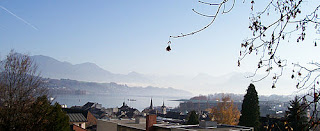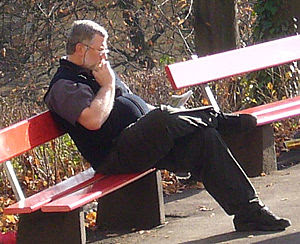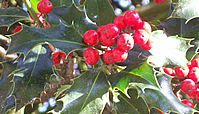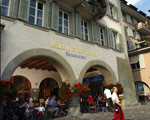On Monday 27 November 2006, after seeing the children off to school, the four of us (Pierre, Ronel, Willem and Leta) drove to Lucerne, only about 40 minutes from Oberägeri by car.

Lucerne (German: Luzern) is the capital of the canton of Lucerne. It lies on the shore of Lake Lucerne (German: Vierwaldstättersee) within sight of Mount Pilatus and the Rigi. The lake covers 114 square km and has a maximum depth of 214 m.
The city grew from a small fishing village of ancient origins on the shores of Lake Lucerne with the founding of the Benedictine monastery of St. Leodegar in around AD 700.

Since the city straddles the Reuss River where it drains the lake, it has a number of bridges. The most famous is the Chapel Bridge (German: Kapellbrücke), a 204 m long wooden bridge originally built in 1333, although much of it had to be replaced after a 1993 fire.


Partway across, the bridge runs by the octagonal Water Tower (German: Wasserturm), a fortification from the 13th century. Inside the bridge are a series of paintings from the 17th century depicting events from Lucerne's history. The Bridge with its Tower is the city's most famous landmark.

Here is a beautiful old wrought-iron bridge over the Reuss. Old Town Lucerne is located just north of the Reuss River, and still has several fine half-timber structures with painted fronts.

This building had a whole family tree painted on its wall.

The City Tower (German: Zytturm) in the centre of Lucerne's Old Town.


These beautiful wooden doors front onto the Kapellplatz in the centre of the Old Town.

Leta and Willem in Lucerne (photo by Pierre), and detail from a fountain. We loved the dragon!


Another fascinating fountain, this one painted in merry colours, complete with medieval soldier at the top, holding a sword and the city flag. This image we came across again later the same day, at the old town wall.


The Old Town boasts many buildings richly decorated with old and beautiful frescoes.

Here is yet another bronze fountain, this one depicting a medieval guy with a goose under each arm. Dinner, perhaps?

A splendid example of the Swiss wrought-iron building signs. This one on the left has the head of some fierce bird at the top, with a prancing stag hanging below.

The painting on the side of this inn says "J. Wolfgang von Goethe logierte hier 1779", which means that Goethe stayed here in 1779. Johann Wolfgang von Goethe (1749 –1832) was a German poet, dramatist, novelist, theorist, humanist, scientist, painter, and polymath.

The fresco on the building housing the Restaurant Fritschi must have been fun doing! It is obviously a modern work of art.

From the lower parts of the Old Town we climbed the hill to the medieval city ramparts, also known as the Museggmauer, or Musegg Wall, complete with nine tall watch towers. We passed the first of the towers quite close to the river without knowing what it was. Afterwards we learnt that this was the Nölliturm.

The next watch tower came into sight while we were still close to the Old Town at the foot of the hill. This is the Männliturm (literally the "man tower"), named after the statue of a guard with sword and flag on top of the tower.

As we walked up the hill, the next tower we saw was the Wachtturm (guard tower). The small chapel in the foreground in this picture stood in the garden of a house and is literally the size of a doll's house.

At his point we were quite close to the top of the hill and here we stopped to take some photos of the most magnificent views over the city. We reached this point at exactly 12 noon and as we stood there we were entertained by the church bells of the multitude of churches and chapels jubilantly chiming the hour. That was a truly awesome experience!

Here we were directly opposite the Zeitturm, or Clock Tower.

A little way further up the path we stopped again for another look at the view over the city. The white streak in the top left-hand corner of the picture is the vapour trail of an aeroplane. We often noticed these vapour trails across the sky while we were in Switzerland, more here than elsewhere in Europe.

We only went as far as the Schirmerturm. The building right next to the wall seems to be a university for music studies and so there were students coming and going while we were up there.

At the Schirmerturm, the gateway tower, one can pass through to the outside of the ramparts.

This is the coat-of-arms of the Schirmerturm.

Willem decided to take a break while the rest of us explored a short distance furhter up the hill.

Still on the outside of the wall, this photo shows, from left to right, the Zeitturm, the Wachtturm and the Luegislandturm.

In a garden next to the path there was a very pretty holly bush, flaming red with berries.

After our strenuous walk up the hill and down again we relaxed over lunch and a good bottle of wine at the Rathaus Brauerei on the riverbank before continuing our explorations.

Downriver the Spreuerbrücke or Mill Bridge zigzags across the Reuss. Here are some pictures of us at the Mill Bridge. Constructed in 1408, it is the oldest covered bridge in Europe and has a small chapel in the middle that was added in 1568. The bridge features a series of medieval-style 17th Century plague paintings by Kaspar Meglinger titled "Dance of Death".
Meglinger's paintings portray various conditions of men and women, priests and warriors, princes and men of learning, the young bride, the devout nun, the lawmaker, the hunter, the miller, even the artist himself, are all depicted at the mercy of Death, with his mocking smile and his ever-changing garb.

The twin needle towers of the cathedral of St. Leodegar sit on a small hill just above the lakefront (seen here at the extreme left of the picture). Originally built in 735, the present structure was erected in 1633 in the late Renaissance style. However, the towers are surviving remnants of an earlier structure.

Walking along next to the river we ended back where we started, at the Chapel Bridge. Once again there were swans in abundance on the river Reuss. Well satisfied with our explorations of the day we made our way back home to Oberägeri.

No comments:
Post a Comment